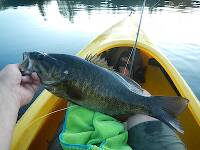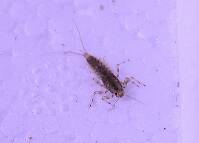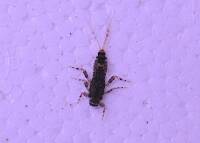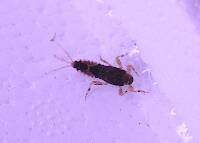
Blue-winged Olives
Baetis
Tiny Baetis mayflies are perhaps the most commonly encountered and imitated by anglers on all American trout streams due to their great abundance, widespread distribution, and trout-friendly emergence habits.
Featured on the forum

This specimen appears to be of the same species as this one collected in the same spot two months earlier. The identification of both is tentative. This one suffered some physical damage before being photographed, too, so the colors aren't totally natural. I was mostly photographing it to test out some new camera setting idea, which worked really well for a couple of closeups.

Troutnut is a project started in 2003 by salmonid ecologist Jason "Troutnut" Neuswanger to help anglers and
fly tyers unabashedly embrace the entomological side of the sport. Learn more about Troutnut or
support the project for an enhanced experience here.
GONZO on Apr 9, 2008April 9th, 2008, 4:32 pm EDT
Shawn,
I really like your drift-sampling idea, but don't be too quick to dismiss Louis'/Walt's Worm. I know what you are suggesting by the "Dog Chow" reference, but I have seen "the professor" catch fish after fish with that monstrosity on streams where the trout have never seen a pellet. Come to think of it, though, I can't be absolutely certain that he wasn't chumming those fish before they hit. OK, just to be sure, let's make a pact to check his pockets the next time he bends that hairy abortion on his leader!
By the way, that's one smart four-year-old. Seems like he's already got six legs up on his daddy in the entomology department! (Just kidding--both of you!)
I really like your drift-sampling idea, but don't be too quick to dismiss Louis'/Walt's Worm. I know what you are suggesting by the "Dog Chow" reference, but I have seen "the professor" catch fish after fish with that monstrosity on streams where the trout have never seen a pellet. Come to think of it, though, I can't be absolutely certain that he wasn't chumming those fish before they hit. OK, just to be sure, let's make a pact to check his pockets the next time he bends that hairy abortion on his leader!
By the way, that's one smart four-year-old. Seems like he's already got six legs up on his daddy in the entomology department! (Just kidding--both of you!)
Kinzua on Apr 9, 2008April 9th, 2008, 5:03 pm EDT
Gonzo, these ideas presented by all have been helpful and thought provoking. Now that the baetis hatch is well under way on Spring, I'm sure the resident trout are feeling the pressure. On my last trip there, I sensed a reluctance of the fish to rise plus got a few refusals and half-hearted takes. I agree with your suggestion that trout are inclined to surface feed only when there is a sufficient food source present to justify the risk.
John S, when the rising ceased, I did run a Sawyer pheasant tail down through a couple runs, but to no avail. Perhaps the fish were full. For a moment I thought about trying a scud or egg, but the draw of rising fish had me off searching other sections of the stream. But it wasn't until the sun began to set, that midges and a few more baetis brought more fish to the surface.
John S, when the rising ceased, I did run a Sawyer pheasant tail down through a couple runs, but to no avail. Perhaps the fish were full. For a moment I thought about trying a scud or egg, but the draw of rising fish had me off searching other sections of the stream. But it wasn't until the sun began to set, that midges and a few more baetis brought more fish to the surface.
GONZO on Apr 9, 2008April 9th, 2008, 5:24 pm EDT
Thanks, Kinzua. I think the scud was a probably good idea, but I'm just very partial to them on limestone waters in general. As John suggests, however, my explanation is also subject to exceptions and a high degree of uncertainty. I just like to quibble to pass the time when I can't fish. ;)
Wiflyfisher on Apr 10, 2008April 10th, 2008, 4:55 am EDT
GONZO, quibbling is good for the heart and sole. :) Besides if fly fishing was easy and predictable would we really enjoy it?
I was thinking while sipping coffee and punching code this morning that trout behavior is also in response to their surroundings too. Your waters in PA do see a lot more fishing pressure than anything I normally fish and it obviously effects the trout's feeding behavior. I would probably pull my hair out if I had to fish elbow to elbow with others on a river. I have had my taste of that I on the Delaware, Beaverkill and Madison.
GONZO, my example was just in fun to get quibbling more. :) The fish were really keyed in the PMDs and we could watch them clearly from the bank. What a wonderful sight to see, until the winds picked up. Obviously, sub-surface for emergers and the sporadic drifting nymphs under the film were selected, but so were some of the occassional floating duns. The trout were wild and a bad cast or movement could put the fish down.
I was thinking while sipping coffee and punching code this morning that trout behavior is also in response to their surroundings too. Your waters in PA do see a lot more fishing pressure than anything I normally fish and it obviously effects the trout's feeding behavior. I would probably pull my hair out if I had to fish elbow to elbow with others on a river. I have had my taste of that I on the Delaware, Beaverkill and Madison.
GONZO, my example was just in fun to get quibbling more. :) The fish were really keyed in the PMDs and we could watch them clearly from the bank. What a wonderful sight to see, until the winds picked up. Obviously, sub-surface for emergers and the sporadic drifting nymphs under the film were selected, but so were some of the occassional floating duns. The trout were wild and a bad cast or movement could put the fish down.
John S.
https://WiFlyFisher.com
https://WiFlyFisher.com
Wiflyfisher on Apr 10, 2008April 10th, 2008, 5:01 am EDT
John S, when the rising ceased, I did run a Sawyer pheasant tail down through a couple runs, but to no avail. Perhaps the fish were full. For a moment I thought about trying a scud or egg, but the draw of rising fish had me off searching other sections of the stream. But it wasn't until the sun began to set, that midges and a few more baetis brought more fish to the surface.
Ah... I thought your original post was referring to the end of the hatch cycle, not a day's hatching. (Next time I will read more carefully.) I probably would have been off searching for another stretch too. :)
John S.
https://WiFlyFisher.com
https://WiFlyFisher.com
GONZO on Apr 10, 2008April 10th, 2008, 5:09 am EDT
Thanks again, John. Actually, we don't really fish elbow-to-elbow that often in PA--it's more like cheek-to-jowl. :)
Wiflyfisher on Apr 10, 2008April 10th, 2008, 11:18 am EDT
Yes, there may be a "smorgasbord" of nymphs and larvae at this time of year, but the explanation also seems to suggest that those benthic invertebrates are constantly available to the trout and easy to capture. Surely, the early Spring underwater smorgasbord also includes some relatively large and meaty items (at least, compared to the little baetids). If these items are readily available for easy capture, it seems to beg the question of why the trout would rise to the little baetids in the first place.
GONZO, I can't let you off that easily. :)
As example, I have on several occasions in the Spring witnessed trout not rising to the emerging insects on certain stretches on my favorite Midwest river. After successfully catching a trout I by accident discovered they were gorging themselves on hellgramites and totally ignoring the hatch. I have never witnessed that except in the early Spring season.
John S.
https://WiFlyFisher.com
https://WiFlyFisher.com
Martinlf on Apr 10, 2008April 10th, 2008, 2:22 pm EDT
Thanks, Kinzua. I think the scud was a probably good idea, but I'm just very partial to them on limestone waters in general. As John suggests, however, my explanation is also subject to exceptions and a high degree of uncertainty. I just like to quibble to pass the time when I can't fish. ;)
Gonzo, Kinzua: Walt's Worm
"He spread them a yard and a half. 'And every one that got away is this big.'"
--Fred Chappell
--Fred Chappell
GONZO on Apr 11, 2008April 11th, 2008, 10:37 am EDT
John, I'm willing to take up the quibbling gauntlet again, but your example seems to support what I was suggesting. Have I missed something?
Wiflyfisher on Apr 11, 2008April 11th, 2008, 2:31 pm EDT
GONZO, the way you expressed it ("seems to suggest") I took it that you were not convinced this could happen.
John S.
https://WiFlyFisher.com
https://WiFlyFisher.com
GONZO on Apr 11, 2008April 11th, 2008, 4:24 pm EDT
Ahh...I see. Never mind.
Quick Reply
Related Discussions
Topic
Replies
Last Reply
5
Jul 23, 2017
by Jmd123
by Jmd123
2
Jul 9, 2018
by Martinlf
by Martinlf
8
May 26, 2007
by Greenghost
by Greenghost







